 By Pepper Parr By Pepper Parr
February 4, 2014
BURLINGTON, ON.
Where would you go if you wanted to figure out what RBA and BPM and SBB meant? You could do worse than talking to someone who has CIA, CCSA, CFE, CGAP, CRMA behind her name, which is what Sheila Jones, the city’s auditor has behind her name.
And she can explain what RBA, BPM and SBB mean and why they are both very relevant and important to the financial management of the city.
Burlington has, up until the 2014 budget year, based its spending on what each department does. City manager Jeff Fielding has changed that approach to a focus on the service that is delivered to the citizens of the city.
The objective is to first identify the services the city is in and decide if these are businesses we want to be in. There are a total of 54 services, of those 13 are internal to city hall – think legal and HR; leaving 41 services delivered to the public. Of that 41 – 31 are delivered by the city. Others are delivered by other levels of government. Region is an example – they handle water and waste removal.
If the residents of the city, and let us hope that it is the residents who make the decision along with their council members, and not just the administrators at city hall, decide a particular service is something they want and are prepared to pay for the city manager will assign responsibility and accountability for the effective and efficient delivery of that service to a specific person.
As a broad approach to the delivery of services it would appear sensible – now how do you define the metrics that will be used to measure the value of the services and determine if it is being delivered in an effective and efficient manner?.
 Sheila Jones, CIA, CCSA, CFE, CGAP, CRMA, Burlington’s first auditor Back in December, at a Committee of the Whole meeting Auditor Jones took Council through a detailed overview that left them with more questions than answers. Jones used about 45 minutes to lay out the changes that were in the works and asked for feedback.
She started by explaining what was going to be fundamentally different.
 The city is moving from a traditional approach to budgeting where all the expenses were attached to a department. They are moving to an approach where the expenses are attached to a service the city delivers. The city administration does see this as an effective way to manage the city. The approach is going to be for staff to provide Business Plans and Cases, Performance Tracking and Monitoring, Performance Reporting and Continuous Improvements.
At the end of this process the city manager expects to be able to ask, and answer two critical questions. There is a third question that you the voter will get to ask and answer.
Fielding is requiring his staff to tell him:
How much did we do?
How well did we do it?
He then wants you, the public, to tell him if you are any better off?
The process he is putting in place certainly has merit. Fielding is the kind of guy who thinks things through but isn’t afraid to change his mind if he didn’t get it right the first time. He has a lot of experience with “unintended consequences”.
The time line for all this:
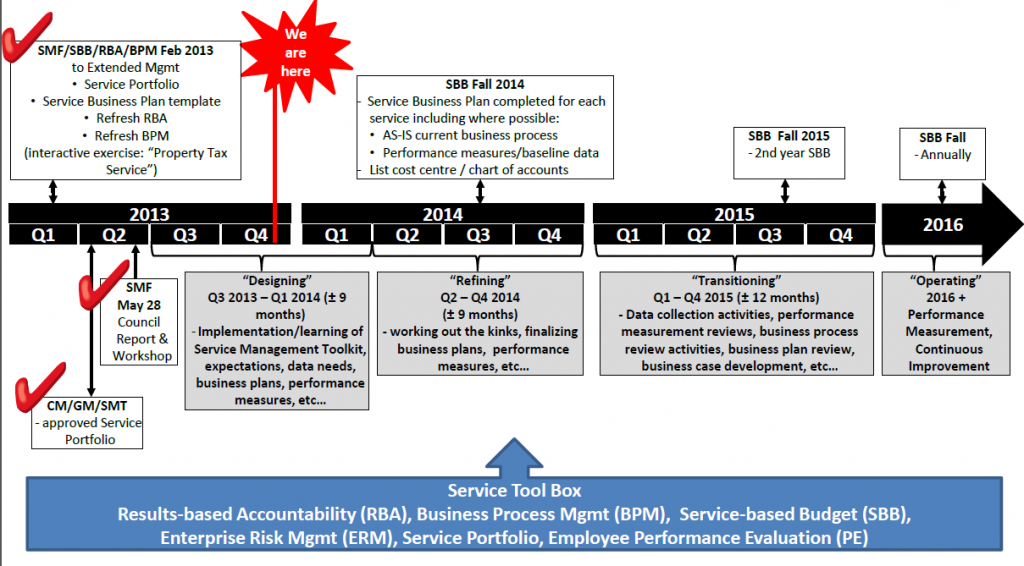 First, if you ever wondered what they do at city hall – charts like this are an example. This was not an easy task. It sets out the time frame to get to the new approach. This will be a very significant shift for staff and will be the making of careers for some and maybe early retirement for those who can’t make the transformation. Public input and education are a critical part of this process. What the city wants to do is promote dialogue about: Service management, Council and Service Owner roles and responsibilities, and the portfolio of services delivered to the public.
The city wants input on the level of service performance accountability reporting people want to see, along with the Importance and value of services delivered.
Auditor Jones wanted to know where Council felt they fit into the process. Were they OK with maintaining a strategic view of services by making decisions regarding commissioning and/or decommissioning of services; increasing and/or decreasing service levels and their appetite and/or tolerance for risk and a review of service portfolio?
Examples of de-commissioning a service can be seen in the 2014 budget. Do you want leaf collection in the fall as frequently; how often do you want sidewalks plowed.
Jones asked: Do you accept Council’s role and responsibilities? 100% they said BUT, …there was still some work to be done to show the link from strategic goals to performance management.
The report that was being discussed set out Senior Management, Service Owner and Staff Role and Responsibilities. Each was to:
Maintain an operational and tactical view of services by: making decisions regarding how services are delivered within the limits of Council approved service levels and budgets; determining, tracking/monitoring and reporting on performance and identifying risks; determining and implementing opportunities for continuous improvement; reviewing services and maintaining the service portfolio based on the decisions of Council.
Jones went on to give a detailed example as to how this would work using Burlington Transit as an example. Those details will be part of a different article.
Everything the city does under the 2015 budget will be somewhere within the Service Portfolio that is currently being revised and refined. That data is expected sometime in the spring when it can ideally become part of the election debate.
At this point in time the service portfolio consists of:
 A Service Portfolio is a list of all the services the city delivers. With the new Service Based Budget there will be a business plan for each service that will be approved by each Council at the beginning of its term of office. This basically sets out what the city is going to deliver.
Full details of that portfolio have yet to be released – there could be some surprises in that document. The core, the foundation of this new approach is the service that the city delivers. What services does the city want to be in and which services does the city want to get out of. This is a Council decision – what staff want to know is: What is the most suitable cycle time for a Council to review the service portfolio? 60% said at the beginning of new council term; 60% said some other time and 20% said at the beginning of each year. That comes to 140% – is this a harbinger of the kind of number stuff we can expect?
Every service will have a Business Plan that sets out the rational, purpose and the expectation the service will deliver. Whenever there is a change to the Business Plan a Business Case has to be provided.
One assumes these business plans and business cases will be on-line, which, if the Strategic Plan is any example, the public will pick up on very quickly and begin to demand that what is published is delivered. Which is exactly what city manager Jeff Fielding wants them to do – he wants the public to hold his staff accountable for his staff to learn to be accountable to the public they serve.
What is going to be in a business plan: Service Banner, Current State, Sub-services, Recent Continuous Improvements Initiatives, Financial Investment, Human Resource Investment, Emerging Opportunities & Anticipated Risks, Measuring Success and Service Objectives.
The presentation was extensive. Each of the parts of the Business Plan had forms that staff had to complete.
It all starts with what city people call the Service banner which a high level view of what the service is, why it is being delivered, what it will cost and how it will be reviewed by city council.
 The document that sets out the high level view of the service being delivered. 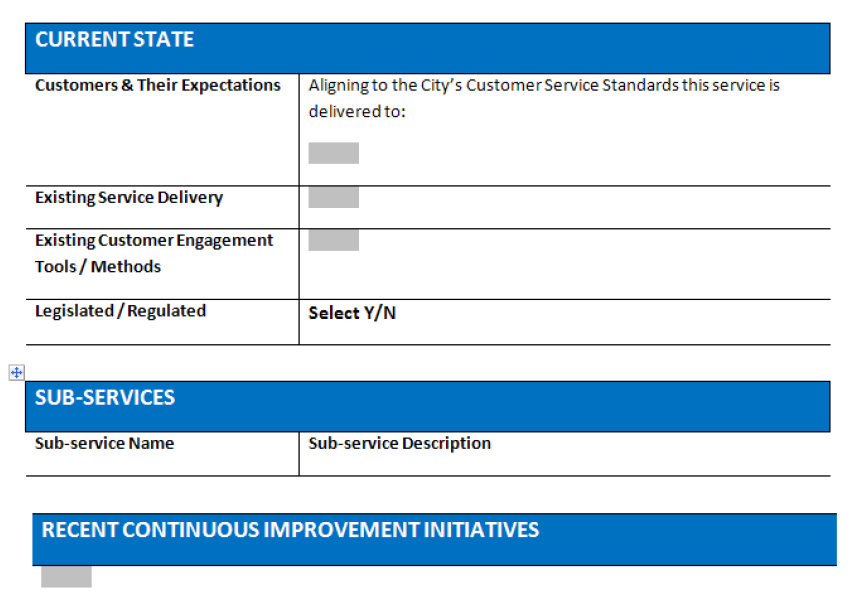 This type of document sets out the working plan for a service. The focus is always on improving the quality of the service and keeping the cost in line.  How much money has to be put into the service and what are the HR needs. Burlington has managed to keep the number of people on staff down – and without the use of all that much in the way of contract work.  City manager Fielding wants to see improvements and realizes that means taking some risks – and some of those risks will not work out. Staff can advise Council, Council has to make the decision. The public has to learn that changes need to be made and that much of the territory we are moving into is uncharted waters. Mistakes will be made and the public is going to have to learn to accept the mistakes. The Pier was not a mistake – but it was a classic example of terrible oversight and shockingly poor management.
 These are the documents that performance evaluations are going to be based on: Did city hall deliver – and if they didn’t, why not and if the why not isn’t satisfactory maybe HR will suggest another line of work – outside city hall.  For city manager Jeff Fielding it is all about improvement in the way services are delivered along with a hard look at what the city wants to actually deliver. Fielding isn’t a hard-nosed, cut everything to the bare bones. He thinks the flowers along main roads is a plus and are a part of what makes Burlington the top city it is – BUT he wants to make sure the public fully understands the costs – and is prepared to pay them. Fielding says the ear he has to the ground tells him the public is prepared to pay the cost for the extras – Council of course has to make that decision. With Council having had an overview of the process Auditor Jones wanted to know how they, Council, wanted to track what was being done.
She proposed that Council review the service portfolio at the beginning of each new council term. The Service Portfolio is that list of all the things the city does – the different businesses they are in.
All the Business Plans for all the services in place would be before Council and be made part of the orientation process for a new council and reviewed again annually during the budget process.
Council would look only at those services that have had a change made to them which would be shown in business cases that would be before Council. Waiting for a staff member to decide a change was needed and that a business case should be written up works only if you have a civil service that is responsive and genuinely feels they are accountable to the public. Many are, quite a few are not – it’s a culture change that is still being created.
Auditor Jones then wanted to know: What is the appropriate frequency of reporting performance
Measures; 40% said quarterly; 40% said semi-annually and 20% said annually
Jones took the middle road and proposed that management report to Council semi-annually to coordinate with financial reporting starting in 2015.
Management proposed to assess quarterly as the methods and data for calculating performance measures become stable, predictable and easy to access. This is a work in process that will need quite a bit of fine tuning.
Jones then poses the critical question: What does the public needs to know? Key messaging would include: what is the service portfolio?; why is it important to them? why should they care?; what is the service management framework?; what is a business plan?; what is service based budgeting?
The intention is to do this work in Q2 2014 using various communications channels along with Council involvement to actively engage the public in a process of education and awareness promotion.
Jones is close to emphatic when she says the city needs this valuable information from the public to assist Council in making decisions about services and service levels and to help administrate and prioritize initiative and activities. The city will begin gathering this kind of information in Q3 of 2014 for the 2015 budget and every year after that to inform the budget process.
What is the most suitable cycle for review of a service?
When a service review is defined as a formal undertaking by the service owner to ensure what is delivered is of the highest value to the community; that it applies best modern practices for cost-effective delivery, and directs valuable, limited resources to the delivery of community valued programs and services, a business case is prepared. The limitation here is that it is the service owner making the decision to review. The city might want to look for a way to pull the public into the process.
Council split on that approach as well: 40% said let’s do it bi-annually; 40% by priority sequence and 20% based on some other criteria.
Management came back with having management determine a service owner and Council requirements and develop a Service Review Framework and Methodology for implementation in 2016.
The public will participate – if you give them the opportunity. More than 70 people turned out for a budget review that was held at the Art Centre. The city didn’t take advantage of the opportunity to hold an event at Tansley Woods, where space is admittedly limited nor did they look at all the space in the Alton Campus.
And that was it – Auditor Jones had set it out for them:
Develop performance measures and complete business plans
Undertake continuous improvement efforts
Develop and implement: service based budget views; service performance accountability reporting and service review framework and methodology. Then educate the public on service management
With just under an hour for the presentation Jones asked: What do you think? And there wasn’t a word, not a peep from one of the council members. All seven members of Council were totally mute. Not a word, not a question. There was no interaction, no debate – nothing, which did not bode well for where this vital initiative for the city is going to go.
What was it that Jones said that stunned the seven? If the elected types don’t respond – what likelihood for a robust public response?
Before this new approach gets taken out to the public a lot more work needs to be done on the current council – because they didn’t appear to get it.
Jones has been the city auditor since January of 2009. A 20 year Royal Bank Financial Group veteran where she ended her career with the ban as senior manager of enterprise operational risk assessments. She also holds business degrees from Dalhousie and Queen’s universities.

 By Pepper Parr By Pepper Parr
February 6, 2014
BURLINGTON, ON.
It’s in the blood. The things we choose to do in life are usually consistent and Burlington’s Paddy Torsney is being consistent with her career – politics.
 Off to New York city to work on a world stage. We are expecting an official announcement any day that she will be at the United Nations as the Permanent Observer for the International Parliamentary Union. Exactly what the organization does and what she will be doing is something we will leave to Ms Torsney to tell us on her return. She was in New York earlier in the week working out the details.
The Union is the focal point for world-wide parliamentary dialogue and works for peace and co-operation among peoples and for the firm establishment of representative democracy
What most of us will want to know is how we look her up when we are in New York and getting the latest on all the hot spots.
Paddy is a member of the Privy Council which means she will be known as the Honourable Patricia Torsney – but Paddy to the rest of us.
Congrats kid!

 By Pepper Parr By Pepper Parr
February 5, 2013
BURLINGTON, ON.
Jeff Black, Manager of Field Services for the Roads and Parks Maintenance (RPM) department thinks he is going to get home and find that his wife has done their driveway – what do you think – is Black in for a surprise?
The RPM people have been at it all day with every piece of available equipment the city has out on the roads along with that from the contractors the city calls in on occasions like this.
Black reports that all is under control and that some of the local roads have now seen equipment. “We have managed to get some of the smaller Courts and Crescents done and with the snow fall now ended and nothing predicted for the rest of the day – it’s clean up for the smaller stretches of road.”
 It was an impressive accumulation of snow. It is putting some pressure on the snow removal budget. Primary and Secondary roads get all the attention in situations like this. The city needs three hours to get all the primary roads done – they try to get that work done before rush hour traffic which had the crews out at 3 am this morning.
Sidewalk clearing will also begin this evening.
Everyone seems to have survived – except for the planned Public Open House scheduled tonight at Appleby Ice Centre for the Burlington Transportation Master Plan and Community Trails Strategy is cancelled.
City arenas, community centres and pools, are open; Burlington Transit continues to provide service today with buses behind schedule due to wintry conditions. Handi-Van buses are also running. Please call the BusLINE at 905-639-0550 for updated information and visit www.burlington.ca/transit.
The city’s roads and parks maintenance team is clearing snow from primary roads, which will be followed by secondary and local roads beginning late afternoon and continuing overnight.
Snow is expected to continue falling until mid-afternoon, with an expected accumulation of about 20 centimetres. Northerly winds of up to 40 kilometres an hour will contribute to blowing and drifting.
Updates on winter operations are provided three times daily at 9 a.m., 4 p.m. and 11 p.m. during winter events at www.burlington.ca/snow.
For news updates, visit the following local media outlets:
CHML 900/y95
The Wave 94.7 FM
COGECO
CHCH News
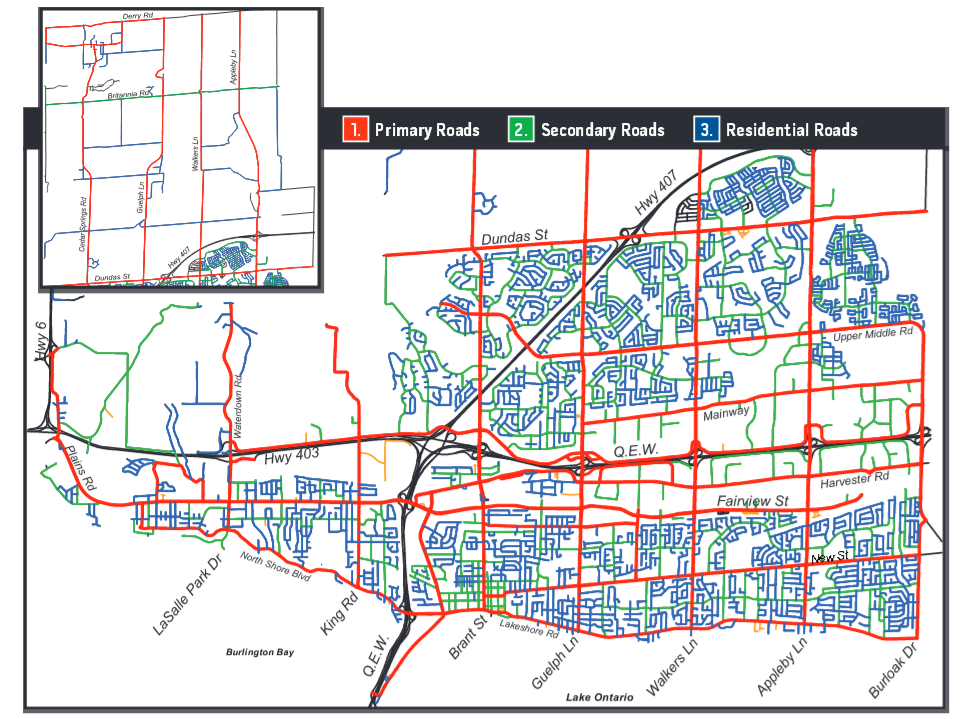 Roads clearing priorities. The listing of the local radio and television stations is a new one for the city. After their dismal performance during the ice storm one must assume there were “words” with that portion of the media. The city hopes Burlingtonians will hear more about local conditions more frequently on the air.
Jeff Black may find that his drive is in fact done. We at the Gazette are very happy that Rob and his snow blower live across the street. Our driveway is clear – thanks Rob. Beer will be in the snow for you to pick up tomorrow; pension check will be in by then.

 By Staff By Staff
February 5, 2014
BURLINGTON, ON.
She was out shoveling snow from her driveway at 6 am and there wasn’t any show falling then but Cathy Robertson, Director of Roads and Parks Maintenance knew she was in for a long hard day. The weather forecasts were consistent – there was going to be a lot of snow.
 She probably isn’t tall enough for her feet to reach the pedals of the more than 25 pieces of heavy equipment she gets out on the road when the snow starts falling by Cathy Robertson, Director of Roads and Parks Maintenance runs a tight operation that clear the city’s primary roads in three hours. Robertson’s day had the 25+ vehicles she has at her disposal out on the roads at 3 am – “we wanted to get one go at the roads before traffic begins and – given that it takes three hours to cover all the primary roads that would get the work done by 6 am leaving room for the commuters.
As soon as the primary roads are done – the equipment gets out and begins work on the secondary roads and, because the accumulation of snow was getting worse, Robertson had her equipment out on the roads doing the primary roads a second time just after 9 am when she hoped the rush hour was over.
The drill is to get the primary roads done, move on to the secondary and back to the primary if that’s what’s needed. If they are caught up then the equipment moves on to the local roads.
For today’s weather Robertson had a handle on it by noon but kept watching the weather reports to get a sense of what was coming our way.
The city has direct access to radar images and uses several weather services. “If we need more detailed reports Robertson said she can call the weather service directly. “We don’t do that very often” she adds “but we can if we have to – there is some amazing detail available from these services.”
 One of the more than 25 pieces of equipment out clearing the primary roads – today they were out at 3 am. What is all this doing to her budget – “We are certainly over” but in November the department was under budget compared to last year and “we base our budgets on five-year averages”. If things really get wild there is a snow removal reserve fund the department can draw on.
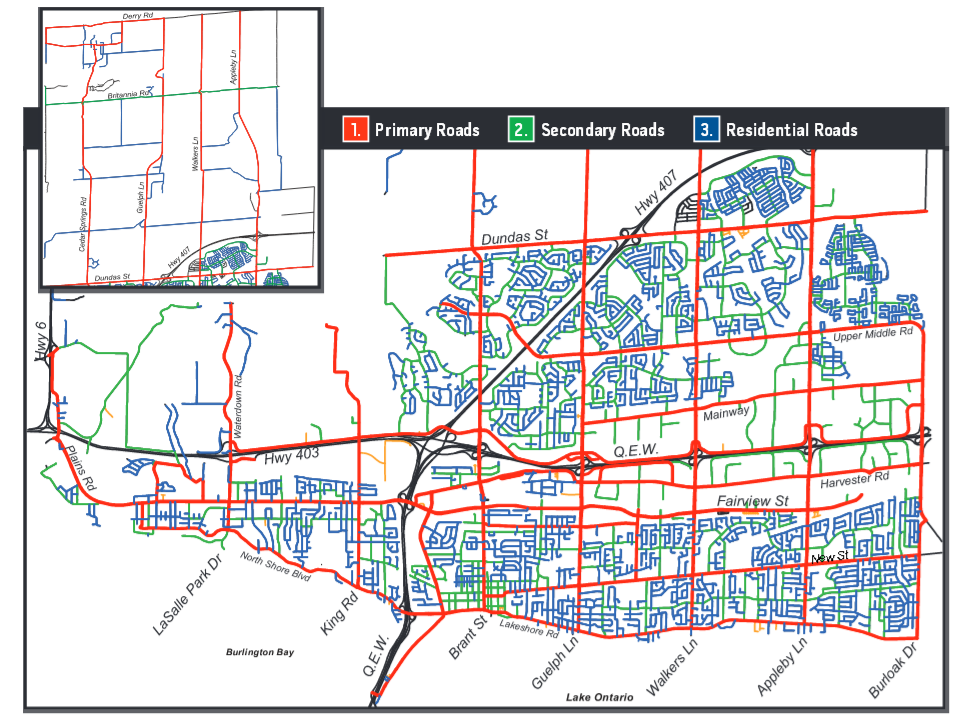 All those roads marked in red get cleared within a three-hour time frame. Pretty impressive. The RPM people break the city into 25 zones with at least one truck assigned to each zone. Three hours to clear every primary road – not bad.

 By Pepper Parr By Pepper Parr
February 5, 2014
BURLINGTON, ON.
I like his idea of service based accountability. I take it to mean that the person responsible for the service is the person accountable – to me. Have I got that right?
So how would this work?
 Anyone having to walk along this stretch of sidewalk to put coins in the parking meter is a brave soul. This view looks north to the meter. Let’s try snow removal – specifically the removal of snow from the city parking lots where we pay directly to use the parking spots – the pieces of which went up 25 cents an hour in January. I can live with that.
Now I know there are people in the parking lot every couple of hours checking the meters because on occasion I have found a piece of paper under the windshield wiper inviting me to have an up close and personal with the cashier at city hall who is going to smile as I remove some cash or a credit card from my wallet.
 The view looking south in lot 4 off John Street – notice how they managed to clear the sidewalk in front of the meter but not for the path to the meter. The meter man will certainly know how icy the lot and the little sidewalk is – but he isn’t accountable for the salting and removal of snow. But could he not put in a call to which over department is responsible and say: “Hey guys – the pathway in lot 4 is iced over”.
How do I as a citizen know who is accountable and knowing who that person is – what do I do? Is the city going to give us the telephone numbers for all these people? A couple of years back General Manager Kim Phillips made it very clear the public would not be given names or phone numbers. Let’s not have the riff raff getting in the way of all the civil servants beavering away on our behalf.
So – just how is accountability going to work itself down to my level and my concerns? It is one thing to say that we have an acronym that makes it all very clear; I just want to know what I can do without having to be on the phone for ten minutes – tying up one of those civil servants working so hard for me.
Call your ward councillor – and if you live in ward 2 – that works; Marianne Meed Ward has been known to slip out of her house on Christmas Day to pick up some garbage left on a street. Many have found that they don’t actually have to live in the ward to get service from her. Ticks off the other council members no end when she crosses those ward boundaries.
The service based approach to budgeting makes sense – what isn’t clear is how to connect that service dot and that budget dot to me.
And when that’s done give me some value for the coins I put in that meter.
To be fair, and a more balanced, as some suggest, the Roads and Parks Maintenance people are swamped and there are a lot of roads and sidewalks to be covered. Do they not have contingency plans for situations like this? This is Canada, this in Ontario – we do snow!

 By Pepper Parr By Pepper Parr
February 5, 2014
BURLINGTON, ON.
Sometime before the snow is all gone – you will be able to hear the dulcet tones of the city manager when he speaks at city council meetings.
City manager Jeff Fielding has a very light voice – he tends not to raise that voice but he can should he choose to do so.
But when he is in the Council Chamber he can’t be heard because the microphones are absolutely terrible. Old fashioned megaphones would be better.
Council members struggle with the on/off button on the units in front of them and all too frequently staff members have to pass a microphone to the person beside them to get one that works.
It has been an embarrassment for more than two years and has made Burlington look like some hick town in southern Arkansas.
Those days have come to an end. The city has put a sumo of $30,000 in the capital budget that will cover the cost of new, much more efficient equipment.
From time to time there are inexperienced staff at the Clerk’s desk and they forget to flick the switch that will “light” the microphone used by speakers at the podium.
If the company that is brought in to do the job gets it right they will have microphones that work for shorter people and well as for taller people. We have watched from the media table as short people stand on their toes to reach the microphone.
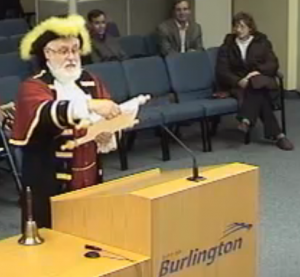 Town Crier David Vollick reading the message from Gazette publisher Pepper Parr at Council in December of 2011. Back in December of 2011 I was unable to attend a Council meeting and sent the Town Crier, David Vollick to speak on my behalf Dave read from a script we had prepared together.
It went over well – Council members were laughing in their seats as Vollick read aloud. Here is what he had to say:
Oyez Oyez Oyez
Your Worship Mayor Goldring, gentle lady and gentlemen of the council, members of the public gallery, I appear before you tonight at the request of, and on behalf of, that epitome of Burlington’s political reporting and punditry – Mr. Pepper Parr.
To his despair he finds that he is unable, not only to attend, to but to document, and disseminate the momentous deliberations and decisions of this the penultimate council meeting of the year of our Lord two thousand, ought ,and eleven.
He bids you to persevere in his absence, and to carry on as sagely, judiciously, and with all due prudence, albeit with the caution that he has come to expect of this august body.
Why you may ask has Mr. Parr sent a young stripling in his stead, and an answer you shall receive.
This very night, yea, in not so many hours hence Mr. Parr, in the precinct of Aldershot in that bastion British values in Burlington, will pledge his troth to his beloved Pia. Yes indeed he has chosen to splice his life line, join in nuptial bliss, to become as one, to slip on that golden ring, in short to join the ranks of married men.
So while it is with regret that he cannot be with you tonight; let it be known to one all that he is in the throes of rejoicing, rapture, possibly stupefaction, bliss, and / or terror as befits a gentleman of mature years, as he is about to embark on the good ship “Married Life”
To one and all who inhabit this hall he sends his true best wishes, but don’t despair he will be here as 2012 commences.
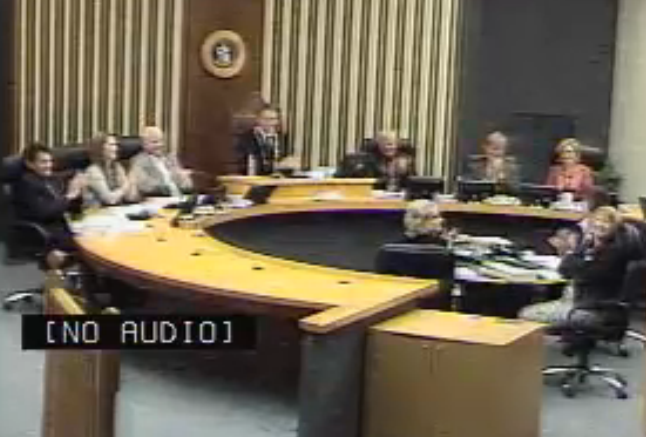 The applause was real enough – but – No audio; a great moment lost. As funny as it was the recorded voice is forever lost – the microphone didn’t work that night.
It will be working properly before the snow is gone. Perhaps we will ask Town Crier Vollick to pronounce on our behalf again. Wonder what we can ask him to say then?

 By Pepper Parr By Pepper Parr
February 5, 2014
BURLINGTON, ON.
It is odd how some politicians see themselves and the impact they have on their community.
Recently an observant reader sent us a note drawing our attention to a document released by Transport Canada on the way different issues relating to local municipal bylaws and provincial regulations were to be interpreted as they related to aerodromes. We did a short piece on the document and brought it to the attention of a senior staff member who trotted it along to the city’s legal department who then ensured that the details in the document were made a part of the city documents package that will get sent along to the Appeal Court in Toronto.
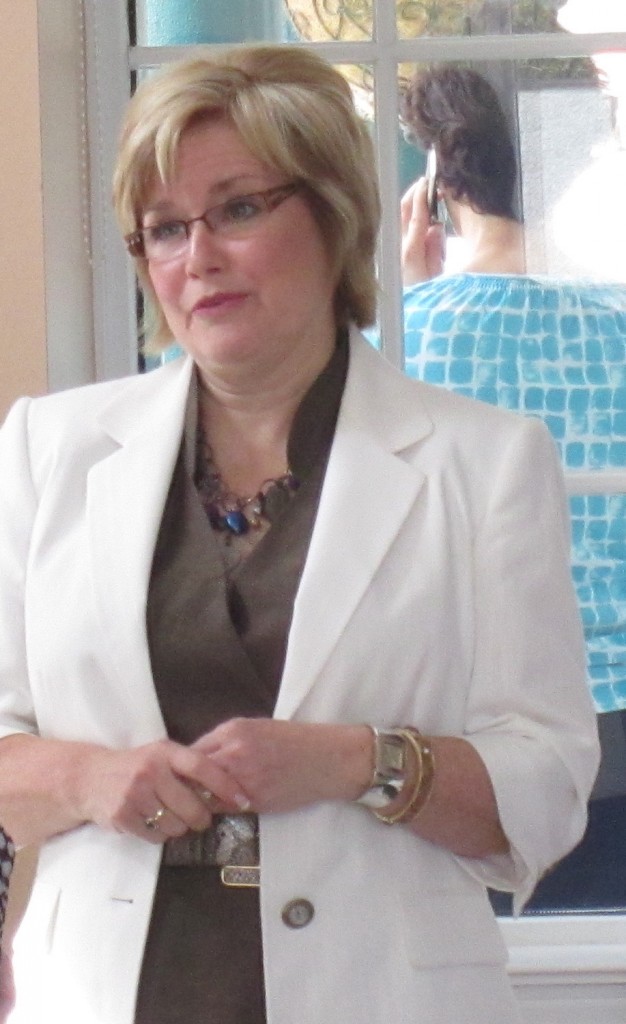 Ward 6 Councillor Blair Lancaster thinking through the answer to a question. Tends to be cautious. Sometime in the near future that Court will set a date and high-priced legal talent will don their robes and argue on our behalf.
The document was an Advisory Circular, something every government department puts out giving their staff directions on how certain issues are to be handled. In this situation the Advisory related to “Land Use and Jurisdictional issues at Aerodromes” which was of particular interest to Burlington given that we are in a long hard battle with the Burlington Executive Airpark Inc., over whether or not they have to comply with the city’s bylaws – they do by the way according to the lower Court Judge Mr. Justice Murray. It is his decision which is being appealed.
The Advisory states “that the Aeronautics Act does not grant immunity to an aerodrome operator/developer from complains with all other valid provincial legislation or municipal bylaws.”
Right on said the city’s legal department and that document got tucked into what they call a Factum and shared with the lawyers on the other side.
During the early days of the airpark kerfuffle the city of Burlington had some difficulty getting any air time with the Minster of Transportation who happens to be none other that the Hon Lisa Raitt, member for Halton just to the north of us. Ms Raitt seemed quite busy and wasn’t all that quick to return the Mayor’s urgent calls.
 Ward 6 Councillor Blair Lancaster at a community event at the Burlington Executive Air Park. She didn’t take it up. There was eventually some communication between the Minister and the Mayor – we gather that Councillor Lancaster was in there somewhere.
During the discussion on the Airpark update – #9 if you’re counting – Councillor Lancaster said she wanted to thank Minister Raitt for all she had done for Burlington on this matter, leaving the impression that the Minister might have even ordered that the Advisory Circular be written and released.
It doesn’t work that way Councillor Lancaster. The Minister might have been vaguely aware of the document. She has had her hands full of oil train derailments which are much “sexier” issues.
Back in 2009 when Raitt was Minister of Natural Resources her press secretary at the time left a tape recording machine at a media event. The device carried a conversation Raitt and her press secretary had about the crisis then over the supply of medical isotopes used in the treatment of cancer.
 Hon. Lissa Raitt, second from the right at an Air Park event with owner Vince Rossi, second from the left. Minister Lisa Raitt called the medical isotopes crisis a “sexy” problem and wanted credit for fixing it, according to the audio. Isotopes were described as a confusing subject by the press secretary to which Raitt replied: “But it’s sexy,” Radioactive leaks. Cancer.”
Unfortunately for Burlington there was nothing all that sexy about a small runway in a rural area – and besides Raitt was palsy with the owner of the airport.
Nice try though Councillor Lancaster.

 By Pepper Parr By Pepper Parr
February 4, 2014
BURLINGTON, ON.
This is a little awkward. How does one write about a person they have never met, who is no longer alive and who is being recommended for a level of recognition few in the city ever receive?
The Halton Regional Police Association have recommended that Bill Henshaw be recognized for his police service by having the street the Burlington police detachment station is on re-named and called Constable Henshaw Boulevard.
They have asked city council to rename Southampton Boulevard, a street that has no residence and serves as the entrance into Headon community that is west of Walkers Line and south of Dundas.
According to city planner Bruce Krushelnicki this has been done just once before in Burlington.
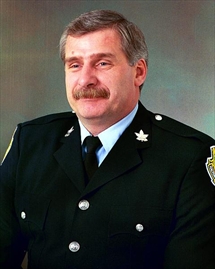 William Charles Henshaw Charles William Henshaw was also current Chief of Police Steve Tanner’s training officer. His colleague Pail Lacourse, Chief Administrative Officer of the Police Association told Council that Henshaw “didn’t aspire to be promoted” – he was a front line officer with a soft spot.
Constable Leslie Bayliss served with Henshaw and told of a Christmas Even in 1999 when a lovelorn American drove up from Buffalo to meet the woman he hoped to marry but had never met. Bayliss described that night this way. The man knocked on the woman’s door, she took one look at him and shut the door in his face. The man didn’t know what to do and he had a problem – there wasn’t enough gas in the tank of his car to get him back to Buffalo. He asked the police for help and Constable Henshaw used his credit card to put gas in the man’s car.
That story says more about the woman who slammed the door and the man who knocked on it than anything else. Does it say enough about a man the police want to have recognized?
Many ask why not name the park to the south of the police station after Henshaw? Much was made of the comments from the delegations but no reference to the letter that was part of the Standing Committee agenda from a resident that did not think the street should be renamed.
The staff report did make reference to the fact that most of the residents that were aware of the idea of renaming the street were opposed.
Councillor Lancaster, who was chairing the meeting, put on her best Miss Canada smiled and said she was proud to move the motion to rename the street after the police Constable. And it was a nice thing to do. Is it the right thing to do?
Councillor has a practice of ignoring what her constituents have to say.
When the city hands out its Burlington’s Best awards later this year – is the focus not on the “best”? We do not take anything away from Constable Henshaw – he appears to have been a fine police officer who died far too young. The man is not the issue – it is the policy and the way the residents who will be inconvenienced for some time by a street name that is the concern.
One resident wrote saying “I have been a resident of this area for more than 20 years and the residential area was established long before the police station was built on Southampton Blvd. Changing the name of a long existing street is confusing an inappropriate for the residents of the area.”
Another 45 year Burlington resident was “disappointed” that the Halton Regional Police Association is requesting that Southampton Boulevard’s name be changed. “I have never heard of Constable Bill and cannot understand any significant local reason for renaming a street after him.”
The resident felt that renaming Newport Park to the south of the police station would be more appropriate.
The Police Services Board sent council a letter asking that “a well-respected, long serving member of the Halton Regional Police Service who died while on duty” be recognized with something that would be “most fitting to honour his service to the community”.
Councillor Dennison had no problems with the idea but he did want to see a sign placed beneath the new street name sign saying “Formerly Southampton Blvd” and kept in place for at least 24 months. His amendment was accepted.
It wold be interesting to see the data on just what residents had to say. This Council wanted to go along with a police association request that was brought to council by its Police Services Board representative Councillor Craven.
A lovely idea – but it is an appropriate one?
Background links:
Bill Henshaw – a cop who worked his beat.

 By Pepper Parr By Pepper Parr
February 4th, 2014
BURLINGTON, ON.
Did you know that the distance between two cities is measured from where the city hall is located? A city hall is the core of a community and if you listen carefully to city manager Jeff Fielding when he speaks you will realize quickly that from his point of view city hall is downtown.
Ward 6 Councillor Blair Lancaster spoke once of a visit to the Ottawa city hall where the place was “buzzing” – “there was a coffee shop in the lobby and it was busy” she told her fellow council members. Burlington city hall once had a small coffee shop but it was in an out of the way location, few members of the public knew where it was and staff didn’t seem to patronize the place – so they shut it down and the space is now a lounge with micro waves and vending machines for staff to use.
 The back end of city hall was added in 1986 and planned to accommodate an additional two floors – is that the solution to the space problems? Burlington has a city hall that was built in 1964, went through an addition in 1986 but that isn’t enough space for the number of people who work for the city. The city rents significant space in the Simms large binders and files tucked under their arms.
 Sometime referred to as “city hall south” the Sims building has housed a number of city departments for a long time. Lease is up in 2016 – does the city renew? Ward 4 councillor Jack Dennison thinks the city could have bought the Sims building with the rent money they have paid during the many years the city has used space in the building. The current lease runs out in 2016. Finance, legal, human resources, purchasing and some Corporate Strategic Initiatives work out of that building.
With the Sims lease coming to an end soon the city is looking at its options. The review is being led by general manager Scott Stewart with a lot of the spade work being done by Craig Stevens. These two handled the second run at the pier and oversaw the city part of the Performing Arts construction – they tend to get it right.
The city has engaged CBRE, one of the largest commercial real estate operations in the country to do a needs study that goes beyond the bums and seats approach to space management.
Their task is to review all the options and come forward with a recommendation.
One of the options is to add two more floors to the additional of city hall that was done in 1986. When that addition was put in place it was designed for two more storeys. That plan has become a bit complicated with changes in the building code that call for changes that were not anticipated back in the mid 80’s
The first task to figure out is just what the city has in the way of property and what it doesn’t have and match that up with what is needed both now and into the future.
Transit is housed on Harvester Road as is Roads and Parks Maintenance (RPM). The team revising the city’s web site works off site and the Cultural Planner will work outside city hall if that position is created. Spreading people who create policy over a number of different locations is not seen as good management. People need to be able to get to each other and to meet casually. Much gets done over the water cooler.
City hall isn’t seen as an efficient structure and it certainly doesn’t have the acronym LEEDS anywhere near it. What does one do with the structure? Enlarge it – there is adjacent land the city could acquire and the space could undergo a major refurbishment. But that doesn’t appear to be the direction the city thinkers are going in.
“What if we could convince a provincial government department to take over city hall, perhaps buy it from us so that the city could put up the kind of building they need” suggested a senior city hall staffer who spoke on background. It was suggested that the city could perhaps partner with a developer and get some class A office space in the city.
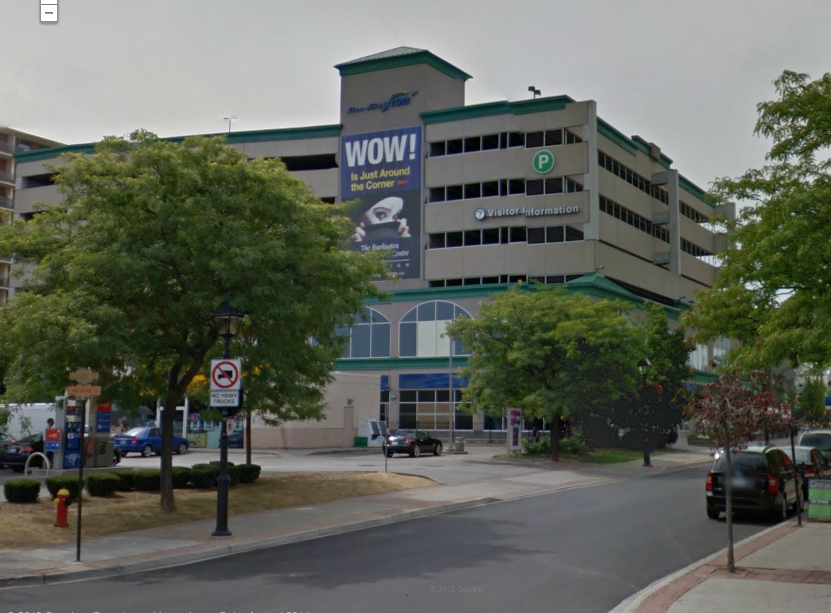 It seemed like a good idea at the time but hindsight may teach us that the parking lot on Locust was not the smartest idea we ever had. Some people look at two significantly located pieces of property that could be re-purposed. The parking garage on Locust Street – part of the dream former Mayor Rob MacIsaac had for the city. The parking space was certainly needed but was property that close to Lakeshore Road with the potential view the smartest place to park cars?
The downtown core is still looking for the “vibrancy” everyone says it has. The impending construction of the Medica One project at John and Caroline will add some vitality to that part of the city and the hope is that additional development will begin to take place along the southern part of John street as well.
Parking lots 4 and 5 on John and Brant Street are locations looking for a purpose. There was a time when McMaster University was going to take up residence there but that one got away on us.
 It has been a number of years getting to the point where there are shovels in the ground but at least this project is going forward. We should see some digging on LAkeshore soon as well when the Bridgewater project begins. The Delta hotel won’t manage to open in time for the Pan-American games. But development and Burlington don’t seem to dance that well. The city is seeing a lot of condo’s and apartment units going up. Molinaro has a project on Brock that is under construction and a multi tower project is on Fairview beside the GO station is being actively marketed.
Project like that solve the direction the province has given the city to add more population. The problem for Burlington is that there are no jobs for those people in Burlington.
The Economic Development Corporation has done a terrible job of attracting new business even though Burlington has a great story to tell. Late in October the BEDC parted ways with their Executive Director – that was 90 days ago and to date there isn’t a hint as to when they will strike a committee to hire a replacement.
Without some serious economic development, all the talk of Prosperity corridors is just so much public relations. The city needs new business that will create additional tax revenue that is vital if residential taxes are to be kept competitive.
That needed economic development will also create new jobs.
Time to begin selling that “Canada’s Best mid-sized city” story to the rest of the world – and that can only happen if there are people who know how to do that kind of work. The kind of people who do that kind of work need to be led by a Board that can actually create a plan and then oversee its execution.
Burlington doesn’t have such a board in place right now. This has to be embarrassing.

 By Pepper Parr By Pepper Parr
BURLINGTON, ON.
February 4, 2014
Jeff Fielding has a problem. It’s a big problem. We aren’t sure exactly when he realized he had a problem nor do we know when he fully realized the extent of the problem. But there is no doubt today that he has got a firm grip on the problem and he can tell you exactly what it is with one simple graph.
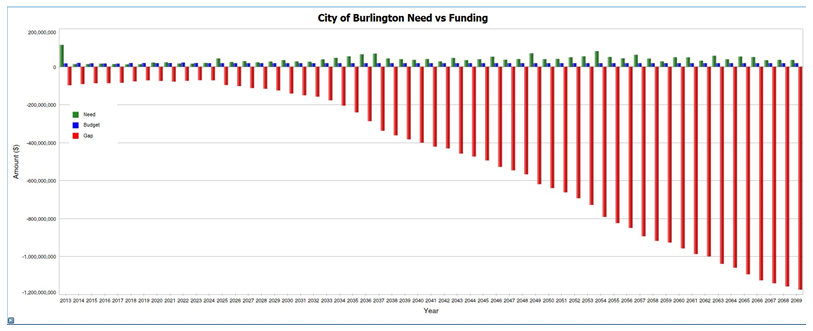 The chart covers a long period of time and it is difficult to read the detail but the trend isn’t hard to miss. Those red lines represent the amount of money the city does not have but needs to spend if roads and other capital assets are to be maintained. Are there efficiencies anywhere? Fielding will tell you that we aren’t in a desperate situation – yet, but he adds that if we don’t do something now – we will be in a close to desperate situation. The problem is with the asset’s the city owns.
In January of last year Fielding briefed Council corporate Asset Management Project. At that time Italo DiPietro and Paul Rohoman were seconded from Engineering to Corporate Strategic Initiatives to give the task the dedicated and focused attention it needed.
The city’s tangible capital assets, based on their replacement value is approximately $2.5 billion. Of this, approximately $2 billion is made up of linear assets including roads, storm sewers, bridges/culverts and sidewalks. A further $295 million is made up of city owned facilities and buildings. Collectively these two categories comprise approximately 92% of the city’s total capital assets as measured by replacement value.
 The objective of this project has been to report on the status of the city’s infrastructure, including adequacy of funding levels in the context of full life cycle needs. Following this, the project team would work with Finance staff on the analysis of funding scenarios and implications for the long-term condition of the city’s tangible capital assets. The objective of this project has been to report on the status of the city’s infrastructure, including adequacy of funding levels in the context of full life cycle needs. Following this, the project team would work with Finance staff on the analysis of funding scenarios and implications for the long-term condition of the city’s tangible capital assets.
In the asset management world seven things matter:
1. What do we own and where is it? (Inventory)
2. What is it worth? (Costs and replacement rates)
3. What is its condition and expected service life? (Condition and capability analysis)
4. What do we need to do to it? (optimum preventative maintenance and rehabilitation)
5. When do you need to do it? (Capital and operating plans)
6. How much will it cost?
7. How do you ensure long-term affordability? (Short and long term financial plan and acceptable risk)
These are large numbers. This is arcane language – only something an account would get excited about. However, if one looks at the data in a format that is easy to understand it evokes an Are you kidding me?
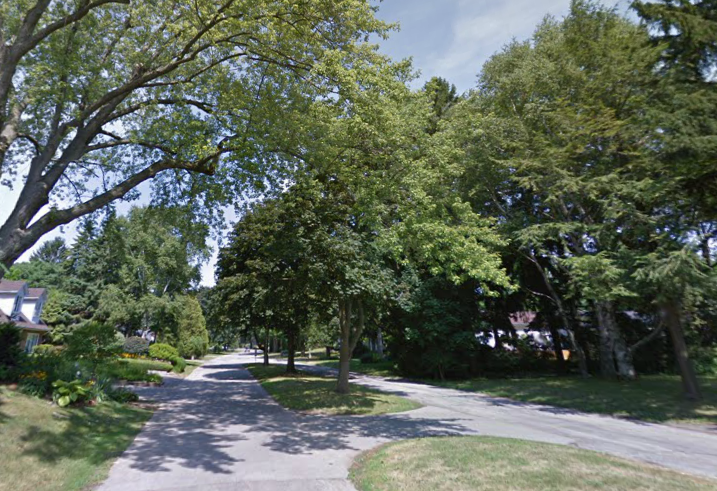 Goodram looking north from LAkeshore: a classic Burlington Street that cost $2.9 million to rebuild just a portion of the street. Last summer Goodram Street was rebuilt. The street was close to 60 years old and its best before date had passed – some time ago. So the city rebuilt the road, rebuilt the sidewalk and the sewers at a total cost of $2.9 million
There were 54 homes on the stretch of street that had the construction work done. Based on the tax revenue the city derives from those 54 homes it will be at least 24 years before the $2.9 million has been recovered. In the meantime of course the city has to provide the good people on Goodram the normal services anyone else gets.
That kind of mathematics is just not sustainable – which is why Jeff Fielding and his staff are looking for more efficient ways to run the city. Somehow we must get a grip on what we are spending on the assets we own.
 Director of Finance Joan Ford does a great job of providing the data and her department does a good job of collecting the taxes as well. It’s the spending side that is causing the long term financial stress. Ms Ford doesn’t do the spending. It is important to note, said a city Corporate Strategic Initiatives (CSI) report that asset accounting is different than asset management. The former is backward looking and is focused on developing an annual charge based on expected service life (amortization period) and depreciated cost based on the acquisition cost (net book value). It is not based on actual replacement cost or actual condition of the assets, and in many cases the actual inventory of assets has been pooled and does not give specific details on an asset itself. Asset management on the other hand is forward-looking and is focused on planning for the maintenance and renewal needs of an asset in the future. It is a management and capital planning methodology. Critical difference that impacts on the way Fielding has to find the money to pay for the replacements.
To provide a full long-term assessment of funding needs, a 60 year time horizon was used for both the facilities and buildings assets and roadways. Meeting new building code and accessibility requirements will add to the actual cost of projects.
 Based on this analysis, the existing backlog of now needs for facilities and buildings is estimated at $13.2 million. With existing funding levels a moderate backlog is forecast to persist on average over the next 25-30 year period. Based on this analysis, the existing backlog of now needs for facilities and buildings is estimated at $13.2 million. With existing funding levels a moderate backlog is forecast to persist on average over the next 25-30 year period.
In the longer term, the forecast for facilities is shown to increase significantly, as long life building systems reach the end of the useful life. The extent of the cumulative backlog will be approximately $25 million at the end of the planning horizon approaching year 60.
Ouch!
The existing backlog of now need roads has been calculated at $105 million. The shave and pave program has extended the life of our roads but there is nothing that can extend them forever. Existing funding levels indicate a major deficit in approximately 2025 which is when a large volume of roads that will be at the end of their useful life and will require full reconstruction.
One of the objectives in the City’s Long Term Financial Plan is Predictable Infrastructure Investment. The city’s infrastructure is aging, and funds must be committed to ensure it is properly maintained and renewed. It is imperative that a strategy be developed in a way that ensures our assets are protected and maintained at minimum cost to the taxpayers.
There are several possible financing strategies available to address the issue of the existing backlog and the growing infrastructure funding gap. Capital from Current funding (Cash) is one of the preferred strategies. It requires detailed planning to ensure that funds can be collected over the life of the asset. . This option would require incremental increases to the city’s existing dedicated infrastructure levy. This would directly impact tax rate increases as well as restrict the ability to utilize property tax levies for other needs.
That last sentence needs to be read a second time. `… require incremental increases to the city’s existing dedicated infrastructure levy. This would directly impact tax rate increases as well as restrict the ability to utilize property tax levies for other needs.
Funds for new project would not be available.
In order to move towards a cash-based renewal program there may be a need to reduce the speed by which the city achieves the optimal life cycle funding level. Lifecycle spending levels may need to be slowed down to match funding capability, and new initiatives and programs restricted to match available funding. Despite these challenges, the cash funding option is preferred due to its sustainability.
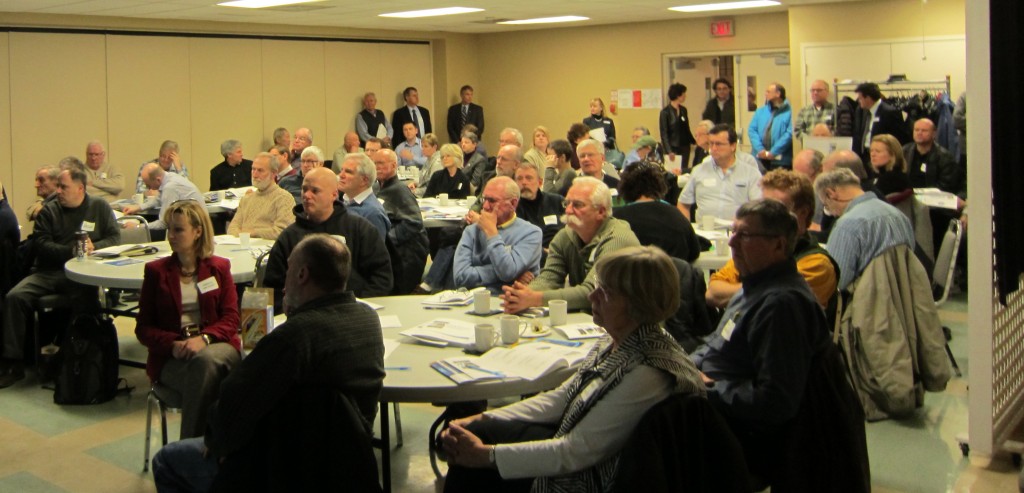 A rapt audience listened to an overview of the 2014 budget. What they have yet to have explained to them is the desperate situation the city will be in ten years from now if something isn’t done in the next few years to figure out how we are going to pay for the maintenance of the roads we have. The city`s reserve funds are improving but the city nevertheless got a “warning” rating when the last report was received.. Drawing upon reserves to fund infrastructure renewal will only be sustainable in the long run, if contributions are made on an annual basis from the tax base and other revenues.
Tax monies put into reserve funds is then not available for other projects.
As well, the city may want to establish a policy of maintaining a minimum balance on the capital reserve funds. This will allow the city to maintain financial flexibility and match funding required by other government grant programs without incurring additional debt.
The Parks & Recreation Department currently adds a surcharge on room rentals and programs at select locations. These funds are then held in a reserve fund for that facility’s capital renewal needs. The practice is not currently in place at all locations and the surcharge being collected is often insufficient to cover all renewal needs. The vast majority of other fees collected across the city are used solely to offset departmental operating costs and do not contribute to facility renewal. Should the city choose to rely more heavily on this source of funding, a review of current revenue policies would need to be conducted to establish where facility renewal costs could be recovered from rates and fees.
The city has recently been successful in the sale of naming rights at the new Haber Community Centre. Annual revenues from this sponsorship arrangement will be deposited in the facility’s reserve fund to be used towards future capital renewal. Additional private sector sponsorship arrangements such as these could be used to address facility renewal at other locations within the city. It should be noted that these options only address the city’s facility infrastructure needs and do not assist with the funding gap for other asset categories.
 Lori Jivan, Acting coordinator of budget and policy patiently leads people through an explanation of the budget and the workbook the city created. Debt financing is beneficial as it can be used to address immediate needs faster than waiting for cash reserves to be built up. However it comes with an additional interest expense. Debt follows the principle of “intergeneration equity”, as it spreads the costs over the taxpayers consuming the asset and the benefit of the capital project over a longer period.
The city has a current debt policy which restricts total debt charges to 12.5% of net revenues.
The city’s long term reliance on debt as a funding source for asset renewal should be phased out as asset renewal is a continual expense requiring a sustainable funding source. However, it may be necessary to incur debt financing in early years in order to include several critical life-cycle projects for which sufficient funds have not been fully set aside. It is also important to keep in mind that when considering the use of debt as a funding source, the city should ensure that it is being used in a fiscally responsible manner and should follow the recommendations of the City’s Long Term Financial Plan.
Other options are:
Divesting of underutilized assets – This option would include the review of assets owned by the city (land and buildings) with the objective of maximizing the value of these assets through sale, partnering on development or optimizing net lease costs received/paid by the city.
Development of other revenue sources. There is a potential to develop other revenue sources through the establishment of city owned development or service corporations.
 Transferring of assets to senior levels of government, for example roads rationalization with the Region. Transferring of assets to senior levels of government, for example roads rationalization with the Region.
Burlington is not bringing in the new employment development. Commercial properties pay more in the way of taxes and cost the city less to service. Residential housing is a loss operation for the city: it costs more to provide the services home owners need than the city is able to collect in taxes.
 Can the city manage its debt and the cost of the infrastructure by pushing some of it forward and having the next generation pay for some of what we need to fix in the next ten years? Could the city use a conversation that would look seriously at the options in front of us? There is one more graph that offers some hope. We continually hear about the baby boomers that are going to retire and cost the city more to provide services for.
The chart above shows where the hope is. While there are millions of baby boomers there are even more millions of Millennials – young people who will want to live and work in Burlington. We need to ensure that there are jobs in the city for them and that Burlington is a city they will want to live in. But that`s 20 years down the road.

 By Staff By Staff
BURLINGTON, ON.
January 14, 2014
How they voted. This is a new, regular feature on how your member of Council voted on various issues. Council members get to vote twice on each matter; once at the Standing Committee where debate is often lengthy. The vote at Standing Committee is not the final vote and it has been the practice of this Council not to publish how each Council member voted.
The Chair of the Standing Committee calls the vote but it is usually very difficult to see who has their hand up and who doesn’t. There are a couple of council members who tend to hide how the voted – the worst offender has been Jack Dennison of ward 4 followed by Councilor Craven of ward 1.
 Your city council members: The Significant Seven. Most of the votes this time out were unanimous with just Councillors Craven and Dennison dissenting on matters. The Gazette wrote to the chairs of the Standing Committees for 2014 and asked that they instruct members of council to show their hands so media could record the vote. Both Councillors Meed Ward and Lancaster complied with the request. Councilor Taylor, at the first meeting this was to happen said publicly “you should have asked for this three years ago”.
Development and Infrastructure meeting January 13th 201There were two Statutory public meetings.
There were no declarations of interest
At most Standing Committee meetings there are items that need no debate and are consented to unless a Council member wants something debated.
The following was approved by consent:
Report approving a variance to the Sign By-law to Permit Additional Ground Signs, Daniel Johnson Architect Inc. – 1900 Appleby Line. (PB-11-14)
The vote was unanimous.
RegularAgenda:
Official Plan Review: Report regarding the Official Plan Review and Preliminary study of the heritage character of theMount Nemo Plateau (PB-07-14)
Report recommendation unanimously approved and sent to Council. Councilor Jack Dennison did not speak to this matter.
Report providing Rail line safety and awareness review(DID-1-14
Report recommendation unanimously approved and sent to Council.
Report providing a response to Provincial consultations on the Land Use Planning & Appeal System (Halton Area Planning Partnership Joint Submission) (PB-14-14)
Report recommendation unanimously approved and sent to Council.
Report providing a progress report and additional funding request on Cootes to Escarpment Ecopark System Project: (CM-21-13)
Report recommendation unanimously approved and sent to Council.
Report recommending information on the feasibility of implementing an Interim Control By-law in the Roseland Community. (PB-16-14)
Staff report was amended to include to continue with the Indian Point study. Approved and sent to Council
Report providing information on Graffiti Prevention and Abatement. (PB-01-14)
Report recommendation unanimously approved and sent to Council.
Report approving proposed Sign By-law amendments related to Banners. (PB-06-14)
Report recommendation approved 6-1 and sent to Council. Councillor Craven dissenting.
Report regarding the rezoning application for 5000 & 5014 New Street. (PB-12-14)
Report recommendation approved 6-1 and sent to Council. Councillor Craven dissenting.
Report requesting a zoning regulation review related to the commercial production of medical marihuana.
Report recommendation unanimously approved and sent to Council
Public Meetings:
Public Meeting No. 1 – Report recommending city-initiated general amendments to Zoning By-law 2020. (PB-03-14)
Report recommendation unanimously approved and sent to Council.
Public Meeting No. 2 – Report recommending city-initiated zoning by-law amendments for home-based businesses. (PB-08-14)
Report recommendation unanimously approved and sent to Council.
Burlington Executive Airport Update.
Confidential matters for consideration:
Confidential verbal update regarding McMaster discussions related to future opportunities.
Confidential verbal update regarding McMaster discussions related to future opportunities.
Afternoon session started at 1:00 pm, adjourned at 3:25
Evening session started at 6:30 pm, adjourned at 10:10 pm

 By Pepper Parr By Pepper Parr
February 3, 2014
BURLINGTON, ON.
What’s in a name and how do you write a report filled with reasons for not doing something and then ignore the people who are going to be impacted and recommending that the name of a street be changed.
That was the predicament city planner Bruce Krushelnicki found himself in when there was a request from Halton Region Police Association to change the name of Southampton Boulevard to Constable Henshaw Boulevard.
In the Staff report, which Krushelnicki signs off on, there is a detailed history of the street and why it was named Southampton Boulevard.
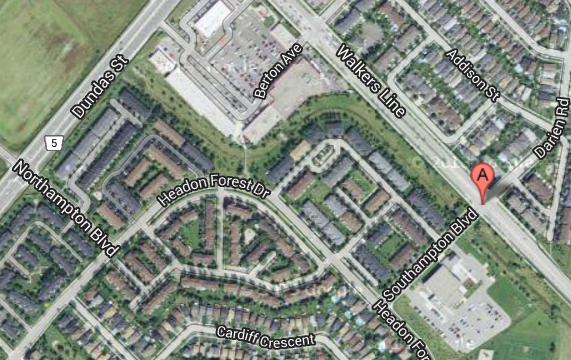 There were good, sound reasons for using the name Southampton for a street in Burlington. It provided a directional focus which is what street names are supposed to do. The subdivision plans for the community and the subject street were registered in 1989. Southampton connects Headon Forest Drive, which is a winding residential street, with Walker’s Line. On the north side of the subject street there is a townhouse development with a driveway onto the subject street. However, the townhouses take their address from Headon Forest Drive.
 The purpose of the street was to give the Headon Forest community access to Walkers Line. The only property that takes its address from the street is 3800 Southampton Boulevard which is the Halton Region Police Service District Office. Southampton Boulevard functions as an entryway into the Headon community.
Southampton, a British port city was for a time the main port of departure, when the White Star Line moved its base there in 1911. The Mayflower set sail from Southampton in 1620.
Southampton Boulevard, has existed for 24 years; it serves as an entryway into the community and for this reason is well-known to those who live in or visit this neighbourhood from Walker’s Line. On the north side of the neighbourhood, Northampton Boulevard provides another entryway to the community connecting Headon Forest Drive to Dundas Street. The naming of these two streets was intended to reflect their relative positions as entryways into the Headon Community. Renaming Southampton Boulevard would remove this association. Many of the streets in the area – such as Cardiff Crescent, Newport Street, Aberdeen Avenue and Leith Avenue – share a common British heritage.
Many of the streets in the area – such as Cardiff Crescent, Newport Street, Aberdeen Avenue and Leith A The street has been known as Southampton Boulevard for over 25 years.
The application for the name change was circulated to owners and tenants within 120 m of Southampton Boulevard. Most of the feedback from the public was against the application. (Was there ANY support for the name change in the community?) The neighbours object to renaming a street with an established name and they question the rational for selecting Southampton Boulevard to honour Bill Henshaw
In the Staff report the following points are made:
The street has been known as Southampton Boulevard for over 25 years.
Southampton Boulevard is a gateway into the community and a reference point for directions.
Constable Bill Henshaw is not a recognizable member of the community.
Before construction of #3 Police Station Halton Region Police Services stated that they did not want to impact the residential neighbourhood.
If Southampton Boulevard is renamed how is the change communicated with emergency services and the public?
Why not rename a new street or another public asset after Bill Henshaw?
All good questions. However, the police have clout and none of the agencies involved, fire, hydro, EMS, school boards have a problem with the name change.
The only objections came from the people who live in the area – and they don’t seem to matter.
Bill Henshaw died in June 2010. He was an officer with Halton Region Police Services. In addition to his service as a police officer, Constable Henshaw contributed to the community by working with at risk youth and various charities.
This decision could become one of those precedents that comes back to bite us.

 By Pepper Parr By Pepper Parr
February 1, 2014
BURLINGTON, ON.
In April 2013 Burlington resident Denise Davy spoke as a delegation at the city’s Community Services Committee, urging the city to take responsibility for the safety of pedestrians at railway crossings. City Council directed staff to consult with community stakeholders to research rail safety.
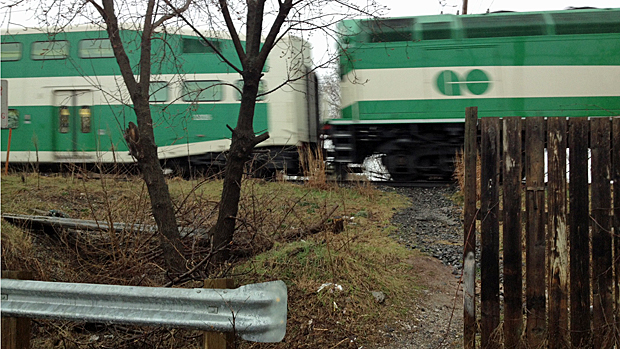 This was the situation in Burlington before Denise Davey delegated to city council for a change. A rail line safety and awareness stakeholder committee was formed to bring the various groups together to review the issue and develop strategies to prevent rail line deaths. The committee included representatives fromGO Transit, CN, VIA Rail, CP, COAST, ROCK, Canadian Mental Health Association, theNorth Halton Mental Health Clinic, Halton Police, Region of Halton Public Works, Transport Canada and theTransportation Safety Board. The review resulted in a number of short-term strategies and long-term opportunities.
 Today there is appropriate fencing and protocols in place to ensure that the city tells the GO people and other authorities that the fence has been breached. It was not quite this easy when Denise Davey first took on the task of making the railway tracks safer by blocking crossing that were not properly secured. Davey’s son, Ryan, was 18 when he was killed by a train in March of 1998. Here is how she tells her story:
“Many more people have been killed by trains going through Halton since then and the numbers over the last year have increased at an alarming rate. In a six-month period, from August 2012 to February 2013, six people were killed, including a 23-year-old Hamilton man.
“That’s a huge increase from previous years and it speaks to the need for better safety measures to prevent further deaths. The area of major concern is along Fairview and Cumberland where many people have been killed by trains.
“It’s wide open and also extremely close to one of the busiest shopping plazas in Burlington. Although there are “Danger” signs posted, the well-worn footpath is a testament to how few people heed them. The same problem exists with the tracks that run between Appleby Line and Burloak, by Sherwood Forest Park.
“Not only are there openings in the fence by the park, but in many areas the bottom part of the fence has been pulled up where people have obviously crawled under. Finding out who is responsible for safety along the tracks was so difficult, however, that even after several calls to rail officials, I’m not completely clear on it.
“Indeed, it seemed even rail officials weren’t clear on it. Transport Canada and the Transportation Safety Board were quick to deflect all blame for any deaths or injuries and talk about the public’s responsibility.
“And there is truth in that. The public needs to be responsible around the tracks. But at some point, the people who run the trains also need to take some responsibility. I can think of several stories I’ve covered as a reporter in which a person was killed crossing the street illegally but a stoplight was later put in place to prevent further deaths or injuries.
“Not only are rail officials quick to deflect blame, they’re tight-lipped when it comes to statistics on train-related fatalities and injuries. After several calls to the GO media folks I was told they don’t have statistics on the number of people who have been killed by GO trains along the Halton tracks.
“How can it be?” I asked the GO spokesperson, “You’re telling me that you don’t know how many people have been killed by the service you run?” I was quickly put on hold then told I needed to talk to someone else. I never got the number from GO.
“I was eventually told by Halton police (who told me earlier they didn’t have the numbers) that five of the six recent deaths in Halton were a result of GO trains.
“I will be talking to members of Burlington city council about changes I think need to be made to areas along the tracks. They include fencing, surveillance cameras, motion sensitive lighting and noise barriers, the same type you see along the QEW in Grimsby.
“I figure if they’re deemed important enough to buffer noise for residents who live close to the highway, they should be considered important enough to save a life.”
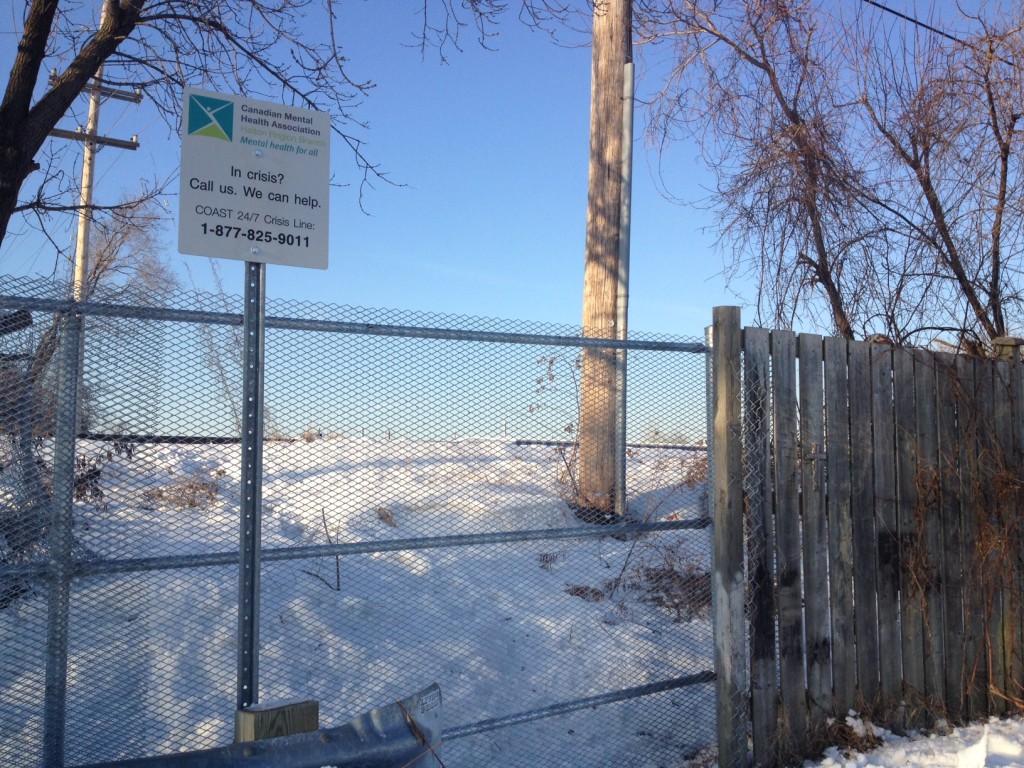 Will the sign make a difference? If it doesn’t – well we tried. But if it does – that is a victory. Denise Davey deserves great credit for her efforts. Keep her in mind when it comes to selecting Burlington`s Best. It was an uphill fight for a long period of time but at a city council meeting in January Bruce Zvaniga, director of transportation services said: “The various stakeholders came to the table prepared to discuss and make changes,” said Zvaniga, and “I would like to thank them for their responsiveness, action and commitment to safety.”
The committee has already put in place a number of short-term strategies, including:
A communication protocol where city staff share information with rail operators regarding fence damage and footpaths near the rail line. Rail operators are also to share information with roads and parks maintenance staff regarding fence damage on city-owned properties
Rail operator “high rail” reviews that exchange information about identified outcomes
City fencing improvements in five different locations where chain fences will be installed
Rail line safety and awareness in 11 public schools and seven catholic schools as part of the schools’ safety awareness programs and under the leadership of Operation Lifesaver
Site specific strategies have been implemented by GO Transit and the Canadian Mental Health Association
“I am very proud of the work done by the stakeholder committee,” said Mayor Rick Goldring. “ The committee has created a set of best practices for the entire country. If what we have set in motion can save one life, than it has well be worth it.”
An annual stakeholder review process is now in place. The stakeholder group will meet each year to look at the outcomes of previous strategies, identify possible new strategies and discuss long-term opportunities. In 2014, the committee will invite the Catholic and public school boards to participate.
Somewhere along the way the woman who had lost a child to a rail line accident got forgotten as all the bureaucrats who should have been on top of this issue from the beginning did nothing until Denise Davey delegated.
The power of one person with a voice and the courage of their convictions is immense and magnificent.
Background links:
City staff directed to start asking questions.
Three deaths in seven months.
Parent wants better rail line safety – death level intolerable.

 By Pepper Parr By Pepper Parr
January 30, 2014
BURLINGTON, ON.
The cat is now out of the bag. The number wasn’t horrendous but it does take the cost of the pier that was over $14 million, and now has an additional $1,228,040 added to that. The actual amount spent was $1,349,952 but the city gets a tax rebate which results in a lower number. We will use that lower number.
And that is before there is any resolution to the legal disputes, which many expect to cost the city even more.
The city released the numbers at a press conference this morning and explained that while doing so went against the policy they put in place December of 2011, the impending decision from the Ontario Privacy Commissioner, forced their hand.
The city apparently decided that they were better off releasing the number of their own volition rather than being ordered to do so by the Privacy Commissioner.
With the legal expenses now public – the city has to consider its options. Settling this case is what seems to be in the offing but nobody is saying anything. There have been offers to settle but it takes two to agree and agreements just aren’t in place yet.
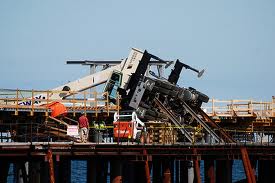 Crane working at the pier site topples. Proves to be the point at which problems with the design became evident. The buzz in the community is that the city does not have a case against Harm Schilthuis and Sons (HSS) and that there is ample opportunity to settle with them. The folks over at HSS have been wanting to settle since day 1 – way back in December of 2010, days after the new Council was sworn in HSS published an open letter in which he said:
Harm Schilthuis and Sons would like to express how encouraged we are by the co-operative spirit we are seeing from the new council in the City of Burlington to resolve the issue of the Brant Street Pier.
HSS is also very pleased at the City of Burlington’s decision to replace Aecom as Project Manager for this project. This will allow the challenges we have raised with respect to the design of the pier to be dealt with in an independent manner. We stand confident that the design build proposal submitted to the City of Burlington earlier this year is the solution to a successful completion of the Pier. The team represents a group of the best companies capable of performing this type of work. Our design build project is ready to begin work in the Spring of 2011.
Also encouraging is the engagement of the City to communicate with the Bonding Company. We are confident that the Bonding Company will be delighted with the opportunity for dialogue. Prior to the election it was quite difficult to have good communications preventing many of the parties involved to understand the various positions. HSS is hopeful that this will be a new day from a communications point of view.
HSS has a number of claims before the city. It wants to be paid the $2 million plus that is due for work done and approved. The process was for HSS to submit their invoices to AECOM, the project manager and for the city. AECOM would approve the invoices and pass them on to the city who would pay those invoices. AECOM was the pier project manager for the city. Included in this $2 million plus are invoices that were approved but not paid and invoices that were submitted but not yet approved.
Where things got dicey for HSS was when AECOM bought Totten Sims Hubicki (TSH) – the company that designed the pier. When it became evident to HSS that the problem was with the design of the pier, it was difficult to argue with the project manager when the project manager now owned the company that designed the pier.
The design problems centered around a significant change back in 2005 when a pier that was to be close to 200 metres (656 feet) long got shortened to 136 metres (446) which is what the pier is now. The original design was much more expensive than the city had hoped it would be – remember, this was back in 2005.
Compromises appear to have been made then, in 2005 that made it impossible for HSS to complete the job despite numerous attempts to make changes
Marianne Meed Ward, who wasn’t a member of Council, was close to screaming when she was telling the public that the organizational arrangement of the pier construction was a problem. The people in ward 2 certainly believed her and now a large part of the city wants to see her as Mayor.
There is a second set of invoices that were submitted to AECOM but had not yet been approved before HSS advised the city that it would not complete the construction of the pier because of a faulty design.
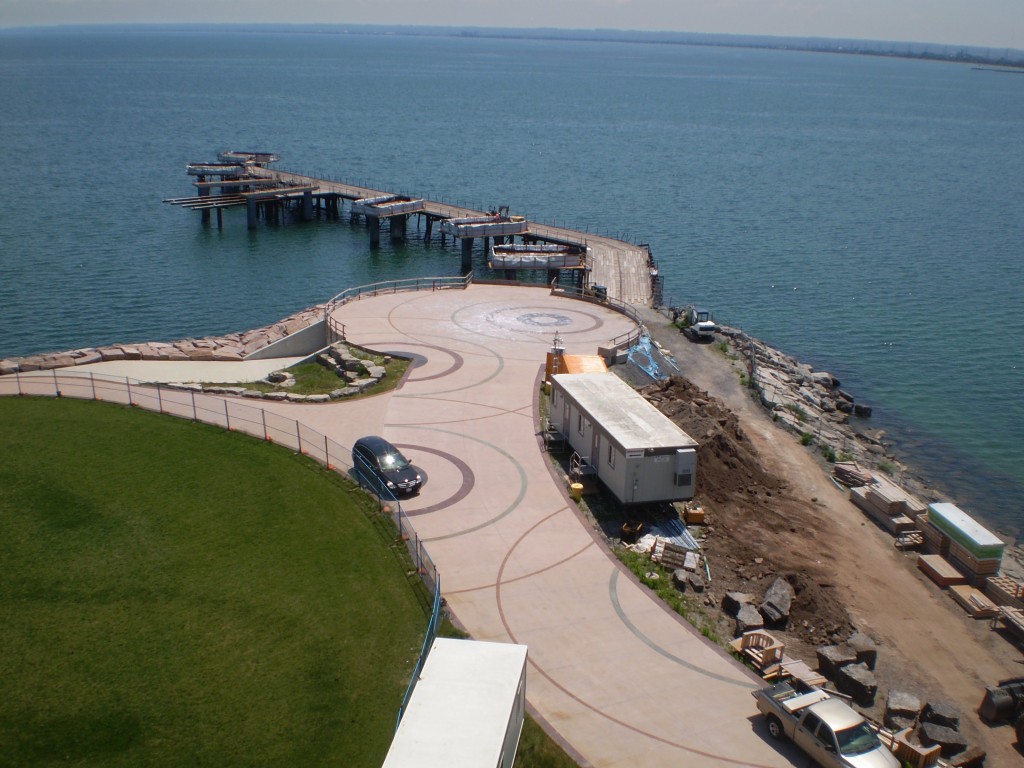 All the steel beams that had been installed are stripped out and construction starts on the second construction contract. The platform on the right is a trestle that was put in place for construction equipment to use. A reliable source informed the Gazette earlier this week that HSS had advised the city it could complete the work for an additional $400,000 – that was back before they sued the city. The offer took place during the Jackson administration and was rebuffed. Current council members Craven, Taylor, Dennison and then ward 5 council member Goldring were all fully aware of the offer HSS had made as was then Mayor Jackson.
Jackson lost the 2010 election during which three new members were elected to Council and a new Mayor was installed. It took this new Council some time to get a handle on the file, which was complex.
With the contractor now off the job, the city called the insurance bond HSS had put in place (they were required to do so) and the insurance company came back with a revised proposal to complete the pier. The city turned down that opportunity without telling the public how much the insurance company proposal was going to cost and decided to re-tendered the project which was given to Graham Infrastructure at cost of $6,429,700.00 and the work continued.
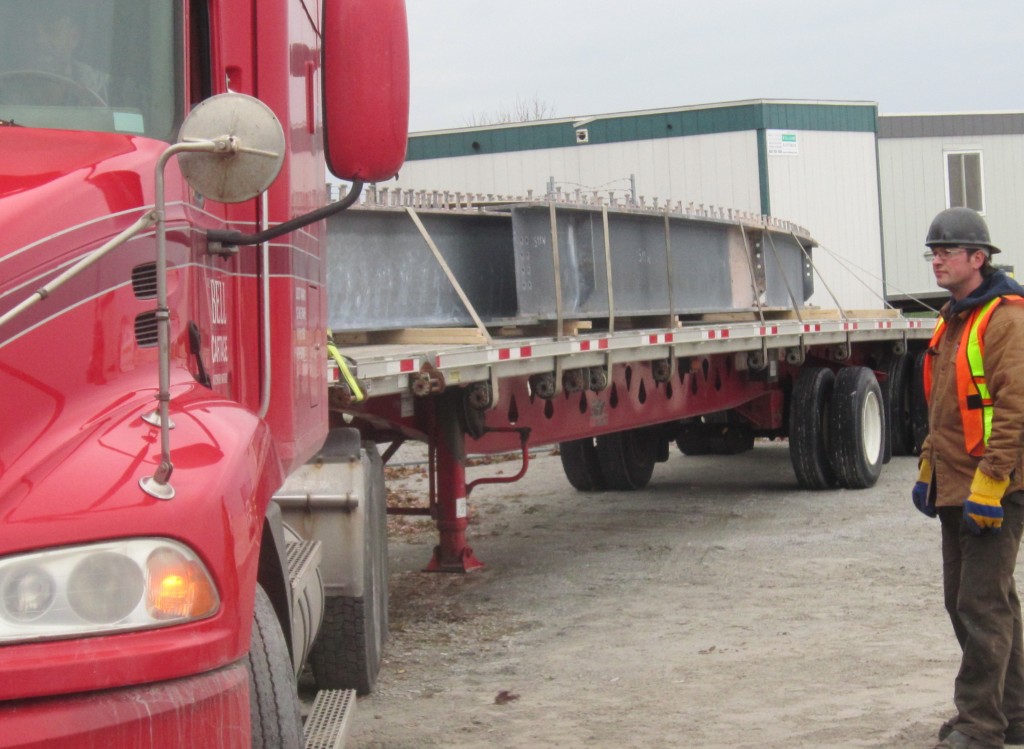 New steal beams arrive – construction is underway and the Mayor announces the pier will be opened in July 0f 2013. Not everyone believes him at the time When the city sued HSS they also sued Zurich Insurance for the value of the performance bond. In attempt to mitigate their damages the insurance company put together a consortium that included Harm Schilthuis and Sons Ltd., the original contractor.
The city received the proposal through Zurich Insurance Inc. in April 2011, but needed time to review the document. City staff provided advice regarding the proposal to members of City Council in a closed session The Mayor then updated the public at the city’s May 11 Community Services Committee meeting.
 Every piece of the new steel used by the second contractor was inspected and then inspected again. The city was not going to get caught with sub-standard steel a second time. Her General manager Scott Stewart, project manager Craig Stevens and the fabrication plant manager close check a beam. “City Council gave careful consideration to what we saw within the proposal before making our decision,” said Mayor Rick Goldring. “Council does not believe that this is the right solution to completing the Brant Street Pier. As such, the city will continue on its path to finding a new contractor.” City council chose not to make the reasons for turning down the proposal public from the insurance company and is proceeding with the plan issue a tender document for general contractors to complete the pier, with that tender expected to be released in July 2011.
All the steel put in by HSS was taken out – new steel put in place and the pier officially opened in June of 2013.
Now the city has to deal with the proverbial chickens that have come home to roost.
HSS claims they have done everything possible to settle the matter but has continually been rebuffed by the city.
City manager Jeff Fielding said at the press conference that there was a mediation date of June 14th but left everyone realizing that not much would happen on that date.
This is an election year for the city. When nominations close late in September city council will lose the power to enter into a settlement agreement. When nominations for public office close Council loses the power to approve any expenditure over $50,000.
The city might find itself facing yet another squeeze play similar to the one with the Privacy Commissioner. Does this Council want to get into an election and have to tell the voters they have been unable to settle the case when it appears that there was an opportunity to settle for one-third of what the to date legal costs have been?
This is an important point: The contractor wanted to be paid for invoices that were submitted and approved. They also wanted to be paid for those invoices that were submitted but not yet approved by then project manager AECOM. There wasn’t any known dispute over the amounts of that second set of invoices;
The contractor was also asking for an additional $400,000 to complete the construction. This addition was to cover the cost of changes that had to be made to rectify the compromises way back in 2005 when the length of the pier was shortened.
This is all very complex but it should not be beyond the capacity of the city’s communications people to explain. The public is not stupid – they know how to do simple arithmetic.
Fielding explained to the media conference that he was leading the event because the file is in the hands of the city manager – it is his problem to resolve based on the instructions he is given by Council.
It is clear then that this council, your council, has not yet given Fielding the authority to settle the matter. Fielding is believed to want to find a settlement the city can live with.
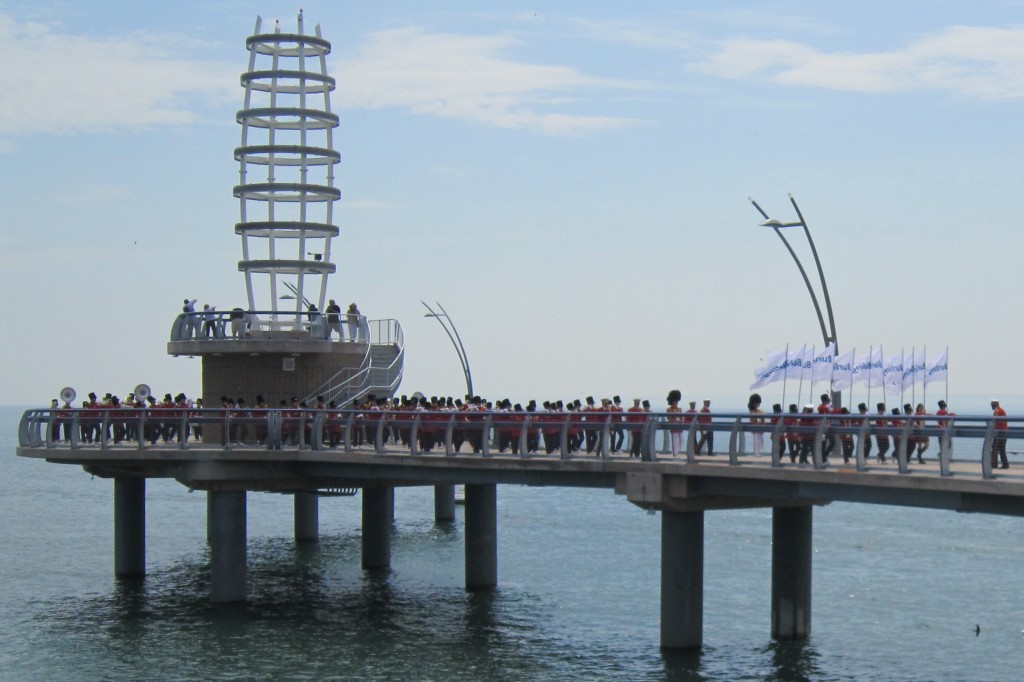 It is a grand pier, a distinct improvement to the waterfront. It was part of the grand plan former Mayor Rob MacIsaac had for the waterfront. It ran into problems that MacIsaac’s replacement couldn’t manage. The current administration made mistakes of its own – the cost of which are not yet fully known. We do know what the legal fess amounted to It might be time for city council to get this behind them rather than face an expensive lengthy trial while the voters decide if they still want this council leading them.
The construction problems with the pier didn’t take place during the life of the current council. However, several opportunities to have the original contractor complete the work for less than has been spent on legal costs was spurned. Now, a Council that could have made better decisions on several occasions find themselves stuck between a rock and a very hard place.

 By Vanessa Warren By Vanessa Warren
January 30, 2014
BURLINGTON, ON
An open letter to the LaSalle Park Marina Association (LPMA),
Last night I attended a public Consultation Meeting and Workshop for the City of Burlington’s 2014 budget.
 Vanessa Warren on the right reading through the city budget workbook at a public consultation last night took exception the way the LaSalle Park Marina association tried to hijack the meeting. Ken Woodruff, former Burlington Green president, is on the left. Full disclosure: I am a farmer in Burlington’s rural north, sit on the board of Burlington Green, and Chair the Rural Burlington Greenbelt Coalition. I had never attended a workshop like this before and to be sure, what got me off the couch and to the meeting was a desire to see that public transit, environmental sustainability and rural issues were being represented within the context of the City’s financial plan; but I also attended because I feel we all have a civic duty to ensure our municipality’s house is in order.
I prescribe to the belief that I cannot ask my government to be accountable to me, if I do not engage with them.
Upon arrival, an encouragingly large group of attendees were put into working groups around large tables, and instructed as to the evening’s ‘feedback’process. We were then given an opportunity to ask questions, and the first two or three queries from the group were salient, intelligent and budget-related; but when John Birch, president of the LaSalle Park Marina Association stood up, it quickly became clear that the meeting had been hijacked.
Some background. The wealthy boat owners at the LPMA, led by rhetorician John Birch, would like to expand their private harbor, currently occupying the waterfront of a public park and further, want the city to provide more funds beyond the $150,000 already given to them to start detailed designs before the environmental assessment challenge is resolved. The crux of the issue, as I and many others see it, is that the desired construction will almost certainly destroy the wintering grounds of 1/4 of Ontario’s Trumpeter Swan population; a population that has been crawling back from the brink of extinction. I would, and have, also publicly argued that there is no demonstrated need for this redundancy particularly in the face of the City’s fiscal concerns, and with a great deal more environmental assessment to come.
However, regardless of your position on the project IT WAS NOT AN AGENDA ITEM at this budget meeting. The LaSalle Park Marina Expansion is not even being considered in the 2014 budget, and yet, the LPMA thought it appropriate to use the workshop as an illegitimate soapbox for its cause.
Many, many people, citizens, City staff, and almost the entire City Council (with the exception of Councillor Blair Lancaster), devoted their time last night to be engaged in the messy process that is democracy. The workshop was well-attended, well-organized, and should have been much more fruitful; instead, we spent a devastating amount of utterly useless time being commandeered by a special interest group railroading a non-budgetary issue.
 John Birch of the LaSalle Park Marina Association, on the left, going through his workbook. John Birch and the LPMA: I find your case for public funding of a private marina totally without merit. However, if you believe it to have merit, and as a “joint venture”of the City of Burlington, then you must follow the public process as it has been laid out. Your project already hangs by a thread of legitimacy, and if you truly believe your cause is just, then you should promote it justly. Engage with the community and your council where appropriate, and where people who have a counterpoint may enter the dialogue as well. The guerilla tactics that you used so disrespectfully last night were disruptive and unprofessional, and from my perspective, only further eroded your project’s credibility.

 By Staff By Staff
January 28, 2014
BURLINGTON, ON.
The police are moving up the food chain. Last week a number of high school students were arrested and charged as Young Offenders.
On Tuesday, the Drug, Gun and Gang Unit executed a Controlled Drugs and Substances Act search warrant at a Burlington residence where a large quantity of drugs and cash was seized:
80.9 grams of cocaine
242 pills of MDMA (Ecstasy)
2.6 grams of MDMA (Ecstasy
33.1 grams of Crystalized Methamphetamine
40 mL of GHB (Gamma-Hydroxybutyric acid)
269.3 grams of Dextrose (Cutting Agent)
Packaging material
Digital Scales
$8,830.00 Currency
3 Cellular phones
 Police charged Stephen LANE (38 years of age) with the following offences and held him for a bail hearing. Police charged Stephen LANE (38 years of age) with the following offences and held him for a bail hearing.
1. Trafficking a Controlled Substance – Cocaine
2. Possession for the Purpose of Trafficking – Cocaine
3. Possession for the Purpose of Trafficking – MDMA
4. Possession for the Purpose of Trafficking – Crystal Methamphetamine
5. Possession of a Controlled Substance – GHB

 By Pepper Parr By Pepper Parr
January 30, 2014
BURLINGTON, ON.
The public got their first chance to see real detail on the proposed 2014 budget. It wasn’t that they didn’t like what they saw – they said they didn’t see enough data and they wanted a chance to talk about the budget before numbers were put out.
A packed room of about 70 people went through a workbook and talked about what they liked and didn’t like. On balance they were prepared to live with the proposed budget – there were the usual few who didn’t want the city taking another dime out of their pockets.
The LaSalle Park Marina Association tried to tilt the scales and had one of their advocates at each of the discussion tables.
Vanessa Warren of the Rural Coalition went to the front of the room and asked the “special interests” refrain from that practice.
In her summation she pointed out that none of the remarks made at the only public meeting being held on the budget would be available before delegations were made. The sense seemed to be that they wanted more information and they wanted it sooner so they could have a real impact.


By Ray Rivers
January 30, 2014
BURLINGTON, ON.
Last week two passengers flying from Toronto to Halifax got carried away and joined the Mile High Club (MHC). On landing the police detained them, and the female ended up getting arrested – which as you can imagine would kind of ruin the moment. Perhaps the most celebrated case of making your own in-flight entertainment was Ralph Fiennes and a very eager-to-please attendant, on route to Bombay from Darwin. Australia. Somebody caught her fixing her skirt as she left the toilet cubicle shortly after Fiennes did.
 Part of the growing up stages? These are the stories of fancy – how many of us secretly wish it were us? And seriously, why would they arrest somebody for doing what comes naturally, providing it was in the confines of a plane’s tiny toilet compartment or discretely in one of those horribly uncomfortable seats. Perhaps the lucky couple should qualify for a medal for having the chutzpah to engage in that kind of near-gymnastic activity, rather than being arrested. Maybe this could be another Olympic event?
Anything to escape from the boredom of listening to those whining jet engines and that annoying intercom. Richard Branson once bragged that he got initiated into the MHC at a very young age – but then what would you expect from a guy who named his airline ‘Virgin’? I once saw an advert for an hour-long MHC private flight for under $500, and our own Justin Bieber reportedly has joined the club, though the HIGH may be just the kind one gets from smoking Rob Ford’s favourite herb.
Then there is the other mile-high club – the one where Canada’s prime minister flies hundreds of business people to foreign lands to expand Canada’s trade opportunities. Jean Chretien first created the Team Canada concept. And last week Stephen Harper flew 200 people to Israel. though I’m not sure why, since we already have a free trade deal with them – one Chretien negotiated back in the 90’s. And our business with that tiny nation will only ever amount to a mere fraction of our total exports.
So what was Harper doing in Israel and why did he bring over so many delegates? The fact is that this excursion wasn’t about trade, it was about politics. Harper apparently believes that if you profess your love enough times you’ll get loved in return. Though, it’s really the votes he wants – enough to give him another ten or so ridings in vote-rich Ontario.
Is it working? The pollsters and pundits will tell you it is, but my friends of Jewish background always seem more insulted than impressed with this kind of deliberate over-the-top pandering. After all, the PM’s love extends shamelessly to any minority group which can return his love at the ballot box. We recall how he performed a masterful grandstand for the Tamil community, refusing to attend an annual commonwealth meeting in Sri Lanka last year.
And there is never a shortage of client groups to love. The recent Ukrainian disturbance, for example, has provided him with a plum opportunity to play up to Canadians of Ukrainian origin. For Mr. Harper and his party all politics is local – and Canada’s foreign policy gets determined by what will win votes back home. That isn’t new and he isn’t the first politician to play politics with international relations, but Harper has turned this kind of pandering into a new art form.
In one of his speeches he talked about Canada’s unquestioning support for Israel as being the right thing to do. But is it? The roadmap to the future for Israel and the Palestinians is either a two-state solution or a one-state solution. Of course a form of occupied single-state is what they have right now. But this situation is unsustainable – a time bomb ticking until violence once again brings chaos and calamity to this part of the middle east.
 Close to 200 people trekked to Israel with the Prime Minister – the public paid for a lot of those airplane seats. And time is also against a two-state solution, which is partly our fault, since Canada’s international posture has helped mitigate against that outcome. John Baird voted against a Palestinian state at the UN and we intervened at the G8 to avoid criticizing Israel’s occupation beyond the 1967 borders. Our recent role in the Middle East has helped enable Israel to flaunt international law, including construction of a barrier through occupied territory, violating UN resolutions and creating new settlements in the occupied territories.
Stephen Harper may claim he is doing the right thing – but his unquestioning support for the status quo in that nation is wrong. While his motives may be genuine, this is not the kind of love that Israel needs. If there is no two-state solution there will be a one-state solution and that will mean the end of the Jewish nation. Israel will not be able to avoid integrating its Palestinian population into an evolved secular democratic state. South Africa, Israel’s one time ally, can provide a working blueprint of how to proceed.
Being a mile above the earth is supposed to provide greater perspective, but our PM was missing the big picture as he and the rest of his 200 mile-high delegates flew in to Israel last week. Just like that couple on the flight to Halifax he is confusing passion for love. What they were doing may have felt like love but it was really just going through a motion.
 Ray Rivers writes weekly on both federal and provincial politics, applying his more than 25 years as a federal bureaucrat to his thinking. Rivers was a candidate for provincial office in Burlington where he ran against Cam Jackson in 1995, the year Mike Harris and the Common Sense Revolution swept the province. He developed the current policy process for the Ontario Liberal Party. Ray Rivers writes weekly on both federal and provincial politics, applying his more than 25 years as a federal bureaucrat to his thinking. Rivers was a candidate for provincial office in Burlington where he ran against Cam Jackson in 1995, the year Mike Harris and the Common Sense Revolution swept the province. He developed the current policy process for the Ontario Liberal Party.
Background links:
Stephen Harper and Israel
A Matter of Principle
Jewish Voters
Harper’s Zeal
Mile High Club
Justin Bieber
Halifax Flight
Two State solution

 By Pepper Parr By Pepper Parr
January 29, 2014
BURLINGTON, ON.
“We would like to invite you to join Insight Burlington – an online, interactive community panel that will give participants an opportunity to engage and connect on a variety of issues. You will be invited to share your thoughts, ideas and insights on a variety of issues that are important to you and the City of Burlington”, said the email.
Sounded pretty straightforward.
“To get started please click on the link below and complete the short survey. It should take you no more than 6 minutes” took less.
You can be part of this Insight panel the city is setting up. Click on the link below and answer the questions and you’re in.
 Knowing what people think helps a city provide the services the city can afford. City manager Jeff Fielding had hoped to have several thousand people signed up and ready to answer whatever questions the city wanted to ask. When there is an issue being considered the city wanted to be able to turn this Insight panel – run a couple of questions by them and factor that “public opinion” into their decision.
The city does not own the software that runs the program and all the background technology that makes the service work is owned and operated by the son of one of the best public opinion polling expert this country has. Angus Reid, basically retired now, serves as a thinker for Vision Critical – the name of the service Burlington bought into.
Who you are is none of the city’s business. They will, for example, know you are 55 years of age, live in L7M 1T5, own your home and have a household income of $119,000. The WHO you are by name – the city will never know – all that information stays on the Vision Critical computers which happen to be located in Vancouver.
The Insight panel is something the city manager has control of – members of council don’t get to put their sticky fingers anywhere near it. They may be asked if there are questions they would like to see posed – but the service is in place for the city administration. It is a tool to help them make decisions.
The Insight Burlington panel is open to anyone 16 years of age and older who is a resident, taxpayer or business owner/operator in the City of Burlington. The goal is to create a panel that reflects the community. It is an opportunity to voice your opinions on a variety of topics and issues related to the city and the services it provides.
The service is described as a part of the Engagement Charter – now there’s something we haven’t heard about for some time.
What fascinates the people at city hall is the granularity the service will give them. Suppose you said you never used transit – they could ask you why and focus on people in specific parts of the community based on the postal code that was captured.
If there is an issue related to parents in the northern part of the city – the postal codes allow survey questions to be directed to people they are relevant to.
If you want to join click on the link below and answer the questions. The system will get back to you letting you know that you are one of the chosen – actually you choose yourself.
The system can’t be gamed, you can’t flood it by having all your buddies, people who think the way you do, register. The software was designed to provide the city administration with a balanced view.
The city manager is starting this with a soft launch – they want to see how well it works. Early thinking had them taking a look at transit but that may have changed.
Leah Bisutti, administrative assistant in City Manager’s Office has what is called “ownership” of the service. Bisutti along with four other people at city hall have been trained on how to set up a questionnaire. The intention is to send out questions frequently but keep them short. And for those with Smart phones – you will be able to respond on the GO train.
Bisutti is excited about the project. Burlington is the first city in Ontario to take this approach to community engagement. The question staff ask is: Will it work, will people take us up on this.
If you registered to become part of the panel – you can expect to see the first set of question within three to five days. I’m excited, Leah is excited and the city manager is hoping that the investment pays off – he doesn’t want to have to tell council that he blew $100,000 on an idea.
 Checking in – being heard. If you didn’t get one; accept this invitation from the Gazette. Join Now
Got questions? Bisutti has an electronic help line – pop her a note and ask your questions. insight@burlington.ca
If you are unable to click on the link above, please copy and paste the full URL below into your browser:
www.insightburlington.com
Background:
City reveals public opinion polling plans, not cheap.
City hall recruits public for opinions

 By Pepper Parr By Pepper Parr
January 29, 2014
BURLINGTON, ON.
Brian Ferguson brings a very personal point of view to what the United Way means to the community. For many it is a charity that helps people less fortunate that we may happen to be.
We have extra money and we give it to the United Way or other organizations – because we want to help. (Why do we call this charity – it’s a social responsibility.) Ferguson makes the point that the United Way isn’t an organization that helps the less fortunate – it helps people who need help.
 Greg Jones, communications advisor with Newalta and Burlington United Way Chair Brian Ferguson go over a few points at a Campaign Cabinet meeting Ferguson’s mother was dealing with cancer; a terrible disease that strikes many homes and families. He was 15 years of age when his Mother was diagnosed with ovarian cancer. Just after his 16th birthday his Mother’s cancer was so bad that she became bed ridden at home, that is when Brian’s family was referred to the Red Cross who would drop off medical supplies and equipment to the house weekly.
Ferguson didn’t know at the time that this portion of the Red Cross was supported by the United Way. “It wasn’t until I started running the United Way Campaign at VMware as the Employee Campaign Chair that I started to learn who the United Way supports, this is when I found out the Red Cross program we relied on was supported by the United Way.”
 Tara Brewer on the right keeps in touch with her co-workers during a meeting while Jason Lemaich gets a bit of work done during a break in a Campaign Cabinet meeting. This wasn’t the last time Ferguson was aided by the United Way. Years later Brian and his wife turned to ROCK for counselling for his family. To help them learn how to co-exist as a blended family while also learning how to deal with his wife having MS and the strain it puts on everyone. ROCK – Reach Out Centre for Kids – is a UW funded agency.
Brian Ferguson isn’t a poor man. He is gainfully employed by one of the sharpest Canadian companies in the high tech field. He travels frequently to California seeking out the best talent there is as a recruiter for VMWare. Are we going to call Brian Ferguson a charity case? He was a man with a problem he couldn’t manage on his own and sought the help he needed.
“From a young age”, Brian will tell you, “my mother taught me the importance of giving back and being an active member in my community. I see my role in the United Way as a way to live my Mother’s legacy while also teaching my children (almost 3-year-old girl and 15-year-old son) the importance of giving back. The motto I live by running the United Way is – our community is not truly great until it is great for EVERYONE.
The theme my United Way Cabinet runs under is: TWW (Together We Win).
 United Way president Len Lifchus appears to be trying to convince Lesley Allison (UW Campaign Director)
that an idea will work: she doesn’t appear to be buying that one. The United Way that Ferguson raises funds for is there in the blink of an eye when you need it the most. The focus this past campaign had three beams of light: From poverty to possibility; Healthy People build strong communities and All that kids can be.
One in three people will use a United Way funded service/program in their lifetime…mostly of the time not even knowing it. “This was me”, adds Brian Ferguson.
Now you know why he was asked to serve for a second year as chair of the 2014 Burlington campaign.
Background:
Fund raising in bits and pieces around the community.
Creating the team that brought in more than $2.1 million for 2013.

|
|





















































 The objective of this project has been to report on the status of the city’s infrastructure, including adequacy of funding levels in the context of full life cycle needs. Following this, the project team would work with Finance staff on the analysis of funding scenarios and implications for the long-term condition of the city’s tangible capital assets.
The objective of this project has been to report on the status of the city’s infrastructure, including adequacy of funding levels in the context of full life cycle needs. Following this, the project team would work with Finance staff on the analysis of funding scenarios and implications for the long-term condition of the city’s tangible capital assets.

 Based on this analysis, the existing backlog of now needs for facilities and buildings is estimated at $13.2 million.
Based on this analysis, the existing backlog of now needs for facilities and buildings is estimated at $13.2 million.


































